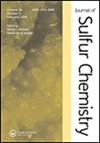碘介导的氧化N-S键形成:无过渡金属条件下1,2,4-苯并噻唑二嗪1,1-二氧化物的简易一锅合成方法
IF 2.1
3区 化学
Q3 CHEMISTRY, MULTIDISCIPLINARY
引用次数: 0
摘要
苯并噻二嗪1,1-二氧化物衍生物因其多样的生物活性和药用前景而被广泛应用。在本研究中,描述了碘氧酮介导的氧化N–S键形成反应。这种新的不含过渡金属的方法允许在非常温和的条件下,在不使用昂贵的试剂和催化剂的情况下,由容易获得的尿素衍生物方便地合成各种1,2,4-苯并噻唑啉1,1-二氧化物。此外,该协议允许开发具有潜在医疗应用的关键构建块库。图形摘要本文章由计算机程序翻译,如有差异,请以英文原文为准。
Iodine-mediated oxidative N–S bond formation: a facile one-pot synthetic approach to 1,2,4-benzothiadiazine 1,1-dioxides under transition metal-free conditions
Benzothiadiazine 1,1-dioxide derivatives are widely used because of their diverse biological activities and medicinal prospects. In this study, iodine-oxone mediated oxidative N–S bond formation reaction was described. This new and transition-metal-free approach allows for the convenient synthesis of a variety of 1,2,4-benzothiadiazine 1,1-dioxides from readily available urea derivatives under very mild conditions without using expensive reagents and catalysts. Further, this protocol allows for the development of a library of key building blocks with potential medical applications.
求助全文
通过发布文献求助,成功后即可免费获取论文全文。
去求助
来源期刊

Journal of Sulfur Chemistry
CHEMISTRY, MULTIDISCIPLINARY-
CiteScore
4.10
自引率
9.10%
发文量
38
审稿时长
6-12 weeks
期刊介绍:
The Journal of Sulfur Chemistry is an international journal for the dissemination of scientific results in the rapidly expanding realm of sulfur chemistry. The journal publishes high quality reviews, full papers and communications in the following areas: organic and inorganic chemistry, industrial chemistry, materials and polymer chemistry, biological chemistry and interdisciplinary studies directly related to sulfur science.
Papers outlining theoretical, physical, mechanistic or synthetic studies pertaining to sulfur chemistry are welcome. Hence the target audience is made up of academic and industrial chemists with peripheral or focused interests in sulfur chemistry. Manuscripts that truly define the aims of the journal include, but are not limited to, those that offer: a) innovative use of sulfur reagents; b) new synthetic approaches to sulfur-containing biomolecules, materials or organic and organometallic compounds; c) theoretical and physical studies that facilitate the understanding of sulfur structure, bonding or reactivity; d) catalytic, selective, synthetically useful or noteworthy transformations of sulfur containing molecules; e) industrial applications of sulfur chemistry; f) unique sulfur atom or molecule involvement in interfacial phenomena; g) descriptions of solid phase or combinatorial methods involving sulfur containing substrates. Submissions pertaining to related atoms such as selenium and tellurium are also welcome. Articles offering routine heterocycle formation through established reactions of sulfur containing substrates are outside the scope of the journal.
 求助内容:
求助内容: 应助结果提醒方式:
应助结果提醒方式:


